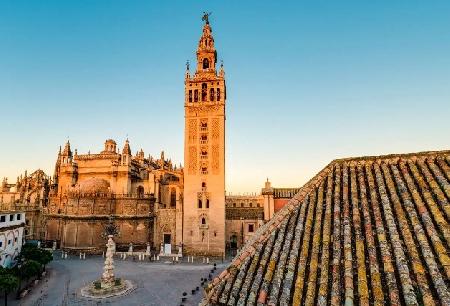 La Giralda is the bell tower of the Seville Cathedral. Although the original mosque was razed to be rebuilt as the Cathedral, the minaret survived to become the most iconic symbol of Seville. The construction of the bell tower began in 1184. The building was designed by the architect Ahmed bin Banu by order of the Abu Yusuf ruler Yaqoob al-Mansour. Construction was not completed until 14 years later. The oldest part of the bell tower is about 70 meters high. It rests on a stone base, the material of which was taken from the buildings of the ancient Romans, so half-colored inscriptions in Latin can be seen on the individual stones.
La Giralda is the bell tower of the Seville Cathedral. Although the original mosque was razed to be rebuilt as the Cathedral, the minaret survived to become the most iconic symbol of Seville. The construction of the bell tower began in 1184. The building was designed by the architect Ahmed bin Banu by order of the Abu Yusuf ruler Yaqoob al-Mansour. Construction was not completed until 14 years later. The oldest part of the bell tower is about 70 meters high. It rests on a stone base, the material of which was taken from the buildings of the ancient Romans, so half-colored inscriptions in Latin can be seen on the individual stones.
This mosque was taken from the Muslims in 1248 and was later used as a cathedral. In the 13th century, the mosque was destroyed, except for the Patio de los Naranjos and the Giralda tower. The construction of the cathedral began in 1403. It is said that when the Christians conquered Seville in 1230, the outgoing Muslims wanted to destroy the minaret but King Alfonso threatened to assassinate anyone who damaged it. The cathedral was finally completed in 1507. The Seville Cathedral was built in a cruciform church with five aisles with chapels. The cathedral is 127 meters long, 83 meters wide and 43 meters high. The Giralda became the model for many towers around the world, from the United States to Russia.
Inside there are 35 inclined platforms, wide enough to allow the muezzin (caller of prayer) to climb to the top five times a day and call the faithful to prayer.
Built in the 1180s, shortly after the Kutubiyya mosque minaret in Marrakesh, and with the same design, by Almohad architects, the minaret was originally 76 meters tall and was once crowned by four orbs, covered with 41 grams of gold. The reflection of the sun that shone on La Giralda dazzled travelers from miles away.
The orbs were destroyed in a 1356 earthquake, from which the minaret survived, and have been replaced by the Christian addition of a bell tower, which brings it to a height of 100 meters. And a statue that symbolizes faith and that also acts as a weather vane (giraldilla) from which we get the name of Giralda. At one point, the flat roof of the bell tower served as a platform for the largest observatory in Europe.
Even without the golden orbs, the Giralda is a sight to behold. Austere but beautiful, the seba (rhombus) friezes are worked in brick relief along all four sides, with pointed arched windows and latticework frames, giving the impression of solid lace.
